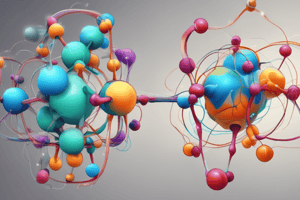Podcast
Questions and Answers
Which type of bond involves the transfer of electrons?
Which type of bond involves the transfer of electrons?
- Ionic bond (correct)
- Metallic bond
- Covalent bond
- Polar bond
What is the suffix used to name the second element in a binary inorganic covalent compound?
What is the suffix used to name the second element in a binary inorganic covalent compound?
- -ous
- -ate
- -ic
- -ide (correct)
Which of the following statements about naming binary inorganic covalent compounds is incorrect?
Which of the following statements about naming binary inorganic covalent compounds is incorrect?
- Prefixes indicate the number of atoms present.
- The first element is named using its full name.
- The second element is treated like a monatomic anion.
- Mono- is used for the first element in the formula. (correct)
What is the primary characteristic of covalent bonds?
What is the primary characteristic of covalent bonds?
Which of the following compounds is correctly named according to the common name convention?
Which of the following compounds is correctly named according to the common name convention?
What must be considered when naming ionic compounds?
What must be considered when naming ionic compounds?
In polar covalent bonds, what is the characteristic of electron sharing?
In polar covalent bonds, what is the characteristic of electron sharing?
Which statement correctly describes the use of Greek prefixes in naming compounds?
Which statement correctly describes the use of Greek prefixes in naming compounds?
Flashcards
Ionic Bond
Ionic Bond
A chemical bond formed by the transfer of electrons between a metal and a nonmetal.
Covalent Bond
Covalent Bond
A chemical bond formed by the sharing of electrons between nonmetals.
Polar Covalent Bond
Polar Covalent Bond
A covalent bond where electrons are shared unequally due to differences in electronegativity.
Non-polar Covalent Bond
Non-polar Covalent Bond
Signup and view all the flashcards
Binary Covalent Compound Naming
Binary Covalent Compound Naming
Signup and view all the flashcards
Common Names
Common Names
Signup and view all the flashcards
Naming ionic compounds
Naming ionic compounds
Signup and view all the flashcards
Naming Binary Inorganic Covalent Compounds
Naming Binary Inorganic Covalent Compounds
Signup and view all the flashcards
Study Notes
Chemical Bonding
- Students will learn to identify the type of chemical bond formed between atoms.
- Students will name given chemical formulas.
- Students will draw the Lewis Dot Structures (LEDS) of atoms and compounds.
Types of Chemical Bonds
- Chemical bonds form between atoms to create molecules or compounds.
- Bonds form due to electrostatic forces between oppositely charged ions, or by sharing electrons.
- Valence electrons are either transferred or shared.
Ionic Bonding
- Ionic bonding involves the transfer of electrons between a metal and a nonmetal.
- Polyatomic cations and anions form formula units.
Covalent Bonding
- Covalent bonds form when electrons are shared between atoms.
- Polar covalent bonds are formed by unequal sharing of electrons (difference in electronegativity is greater than 0.4).
- Nonpolar covalent bonds share electrons equally. (difference in electronegativity is less than or equal to 0.4).
Naming Ionic Compounds
- The element farthest to the left in the periodic table is named first.
- The second element is treated as an anion, with the suffix -ide added to it.
- Use prefixes from Greek stems to indicate the number of each atom in the compound.
- Mono- can be used if a prefix is needed for the second element, but never used for the first.
Common Names
- Some compounds have common names alongside their systematic names.
- Examples: H₂O (water), NH₃ (ammonia), B₂H₆ (diborane).
Compound Formula Naming
- Write the compound's formula.
- Identify the element's name farthest to the left or bottom of the periodic table to form the first part of the compound name
- Identify the second element, treat it as an anion, and add -ide to the end of the root name.
- Add prefixes to indicate the number of each different type of element.
Naming Compounds: Examples
- The provided example compounds should be studied and practiced.
- For example: NH₃, H₂, CH₄, HF, PF₅, SF₆, CO, CO₂, NO, N₂O, NO₂
Identifying Compounds
- Naming Ionic and Covalent compounds includes naming the cation before the anion
- Subscripts are not included when naming ionic compounds.
Examples of Ionic Compounds
- The examples listed include compounds like; CaO, Fe₂O₃, NaCl, CaCl₂, (NH₄)₂S, AlPO₄, and Fe₃(PO₄)₂
Lewis Dot Structures (LEDS)
- Drawing LEDS of atoms and compounds is a skill to be learned.
Studying That Suits You
Use AI to generate personalized quizzes and flashcards to suit your learning preferences.




